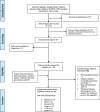Prevalence of obesity among school-age children and adolescents in the Gulf cooperation council (GCC) states: a systematic review
- PMID: 30637108
- PMCID: PMC6323696
- DOI: 10.1186/s40608-018-0221-5
Prevalence of obesity among school-age children and adolescents in the Gulf cooperation council (GCC) states: a systematic review
Abstract
Background: The Gulf Cooperation Council (GCC) countries have among the highest prevalence of adult obesity and type 2 diabetes in the world. This study aimed to estimate the recent prevalence of obesity among school-age children and adolescents in the GCC States.
Methods: The literature search for obesity prevalence data was carried out in July 2017 in Google Scholar, Physical education index, Medline, SCOPUS, WHO, 2007-2017, and updated in November 2018.In addition, 22 experts from the GCC were contacted to check the search results, and to suggest studies or grey literature which had been missed. Eligible studies were assessed for quality by using the Joanna Briggs Institute (JBI) tool for prevalence studies. Conduct of the systematic review followed the Assessment of Multiple Systematic Reviews Tool (AMSTAR) guidance. A narrative synthesis was conducted.
Results: Out of 392 studies identified, 41 full-text reports were screened for eligibility; 11 of which were eligible and so were included, from 3 of the 6 GCC countries (United Arab Emirates, Kuwait, Saudi Arabia). Surveillance seems good in Kuwait in compared to other countries, with one recent national survey of prevalence. Quality of the eligible studies was generally low-moderate according to the JNBI tool: representative samples were rare; participation rates low; power calculations were mentioned by only 3/11 studies and confidence intervals around prevalence estimates provided by only 3/11 eligible studies; none of the studies acknowledged that prevalence estimates were conservative (being based on BMI-for-age). There was generally a very high prevalence of obesity (at least one quarter-one third of study or survey participants obese according to BMI-for-age), prevalence increased with age, and was consistently higher in boys than girls.
Conclusions: The prevalence of obesity among school-age children and adolescents appears to have reached alarming levels in the GCC, but there are a number of major gaps and limitations in obesity surveillance in the GCC states. More national surveys of child and adolescent obesity prevalence are required for the GCC states.
Trial registration: PROSPERO registration number CRD42017073692.
Keywords: Adolescents; Body mass index; Children; Gulf cooperation council (GCC); Obesity; Systematic review.
Conflict of interest statement
Not applicable.Not applicable.The authors declare that they have no competing interests.Springer Nature remains neutral with regard to jurisdictional claims in published maps and institutional affiliations.
Figures
References
-
- Abdul-Rasoul MM. Obesity in children and adolescents in gulf countries: facts and solutions. Advances en Diabetología. 2012;28(3):64–69. doi: 10.1016/j.avdiab.2012.04.001. - DOI
-
- Al-Haifi AR, Al-Fayez MA, Al-Athari BI, Al-Ajmi FA, Allafi AR, Al-Hazzaa HM, Musaiger AO. Relative contribution of physical activity, sedentary behaviors, and dietary habits to the prevalence of obesity among Kuwaiti adolescents. Food Nutr Bull. 2013;34(1):6–13. doi: 10.1177/156482651303400102. - DOI - PubMed
LinkOut - more resources
Full Text Sources


